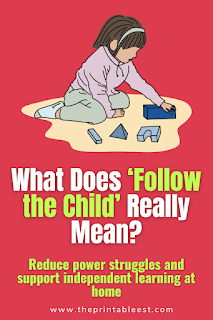How This Montessori-Inspired Principle Reduces Power Struggles and Sparks Independent Learning
“Follow the child.”
It sounds poetic. Wise. Empowering.
But what does it actually look like in everyday parenting—or at the kitchen table during homeschool?
Too often, “follow the child” gets mistaken for “let them do whatever they want.”
But that’s not what Maria Montessori meant. Not even close.
In this post, we’ll explore:
- What following the child really means
- Where it comes from
- How to apply it in modern parenting (without chaos)
- And how it leads to deeper focus, confidence, and joy in learning
🌱 The Roots of the Phrase: “Follow the Child”
The phrase comes from Dr. Maria Montessori, a pioneering Italian physician and educator.
She believed that children are innately driven to learn, and that our role is to observe, respect, and support their natural development—not control or interrupt it.
“The child is both a hope and a promise for mankind.” — Maria Montessori
To follow the child means:
- Trusting their inner rhythm
- Providing tools and structure, not just rules
- Observing instead of constantly correcting
- Letting curiosity lead—not just curriculum
🚫 What “Follow the Child” Is Not
Let’s clear up some myths.
It doesn’t mean:
- Letting kids run wild with zero limits
- Avoiding all structure or schedules
- Giving up your role as guide or parent
- Ignoring red flags or developmental needs
It does mean:
- Slowing down enough to notice what your child is ready for
- Allowing their interests to shape the direction of learning
- Supporting—not scripting—their growth
🔄 Why It Works: The Brain Science Behind It
Children learn best when they feel:
- Safe
- Seen
- In control of their process
When we follow the child, we:
- Tap into intrinsic motivation (they want to learn!)
- Reduce resistance and power struggles
- Build executive function skills like planning, focus, and emotional regulation
- Encourage confidence and resilience
In contrast, when we push too hard or ignore signs of readiness, kids may shut down, resist, or become dependent on adult direction.
🧠 Real-Life Examples of “Following the Child”
Here’s what this looks like in action:
1. ✏️ Writing
Instead of: “Write this sentence I gave you.”
Try: “What story do you want to tell? Let’s write the first part together.”
2. 📚 Reading
Instead of: “You must read this book.”
Try: “You get to pick one book today—I’ll read it with you.”
3. 💬 Emotional regulation
Instead of: “Calm down right now.”
Try: “Would you like a break or a hug?”
4. 🧩 Play
Instead of: “Stop playing and focus!”
Try: “What are you building? Can we add some numbers to it?”
🧠 You’re still guiding—but you're inviting, not commanding.
🛠️ How to Follow the Child at Home Without Losing Your Mind
You can absolutely embrace this mindset without chaos. Here’s how:
✅ 1. Observe Before You React
Watch how your child engages with materials, time of day, people. What lights them up? What drains them?
✅ 2. Provide Open-Ended Tools
Offer choices like:
- Art supplies
- Printables with multiple uses
- Books across topics
- Montessori-style trays with puzzles, sensory tools, or simple challenges
✅ 3. Set Boundaries That Support Freedom
Montessori classrooms aren’t free-for-alls—they have freedom within structure.
Example: “You can pick any of these three learning tasks this morning.”
✅ 4. Be Curious, Not Controlling
Instead of rushing to correct or “fix,” ask:
- “What are you trying to do?”
- “What could happen if we tried it another way?”
- “What’s your idea?”
✅ 5. Trust That Growth Isn't Linear
Following the child means letting go of rigid timelines. Progress isn’t always measurable by worksheets. Some of the most important learning happens when nothing looks “productive.”
🎯 The Big Picture: Why Following the Child Builds Independent Thinkers
Children who are allowed to lead parts of their own learning journey:
- Develop stronger decision-making skills
- Build real confidence (not just praise-based)
- Become lifelong learners who seek meaning, not just approval
And let’s be honest—it makes parenting feel more connected, too.
❤️ Final Thoughts: You’re the Guide, Not the Boss
Following the child doesn’t mean giving up your role.
It means stepping into it more deeply—with presence, patience, and partnership.
So the next time your child veers off course, asks 47 questions about snails, or turns math into a puppet show…
Pause. Smile. Ask, “Tell me more.”
That might just be the beginning of a truly independent learner.











0 Comments